When building or repairing a fence, one question often arises: whether or not both sides need to be sealed.
There are a few different factors to consider when answering this question, such as the material of the fence, the weather conditions in your area, and the fence’s purpose.
Let’s take a closer look at the benefits and drawbacks of sealing both sides of a fence and provide some tips on properly sealing a fence to ensure it stays in good condition for as long as possible.
Why Fence Staining On Both Sides Is Important
For the safety of your fence, you must stain your fence regularly. It is still possible for rot to spread even if your fence is pressure treated. Wood eventually grays and wears out due to the chemicals and natural oils drying out.
It also creates a barrier against precipitation and solar rays since fence staining replenishes the shield on the pickets. Imagine it as a top coat for your nail polish or as wax for your car.
When You Stain A Fence Do You Do Both Sides?
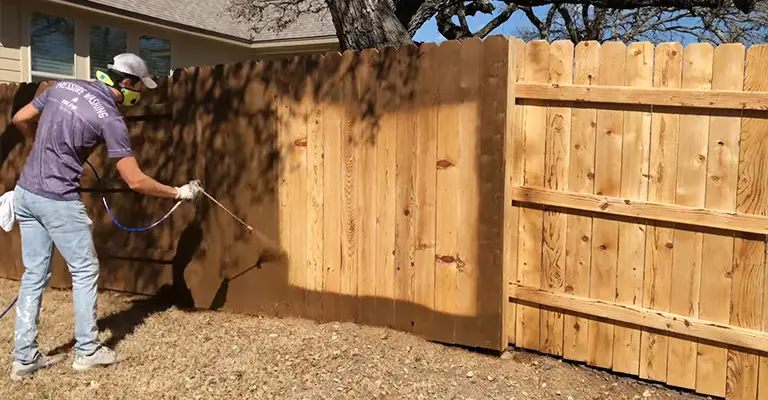
You should stain one side of your fence and one side of the other. In addition to looking more aesthetically pleasing to all parties involved, it will also prolong the lifespan of your wooden fence.
You should consider sun protection in the coming months as the days get longer and the sun beats down a little harder.
In the same way, you apply sunscreen to your skin to protect it from the sun’s harmful rays; the stain can help protect your fence from those harmful rays.
In addition to protecting your fence from insect infestation, the stain can also protect it from rot. Your arm or leg would not benefit from sunscreen applied only halfway.
First, you should remember that new fences shouldn’t be stained immediately. When wood is wet, the stain will not penetrate and does not protect the wood as effectively as it should.
You can test the readiness of your fence to stain by pouring a few drops of water on it. Wood that beads up indicates that it is too wet.
Nevertheless, the staining process is ready if the water soaks into the wood. Two to three years is usually enough time for wooden fences to be repainted.
Don’t Leave The Other Side
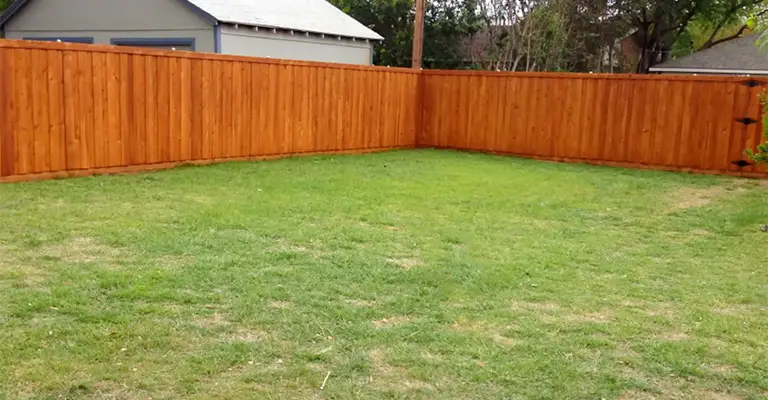
Leaving the other side of the fence untreated is a risk if you stain only “your side” of the fence. You may even be hindering the evaporation of rainwater on both sides, causing more harm than good.
By staining the fence all around, you create an envelope that keeps rain away from the wood. The barrier will trap water behind itself if it can only protect one side. Staining both sides of your fence is the only way to ensure its protection.
The process is simple if the fence is entirely on your property, but it is more complex if neighbors are involved. You can count on us to guide you through this process, and we would be happy to work with you to get both fence sides stained.
Staining the Outside
Staining the outside of the fence may be all that homeowners want to do. Those with a fence that can be seen from the front will think it’s essential to match their exterior design aesthetic.
In addition to adding curb appeal, staining the exterior will also enhance its appearance. In addition, if you have neighbors next door, they may appreciate seeing a nicely stained fence.
Staining the Inside
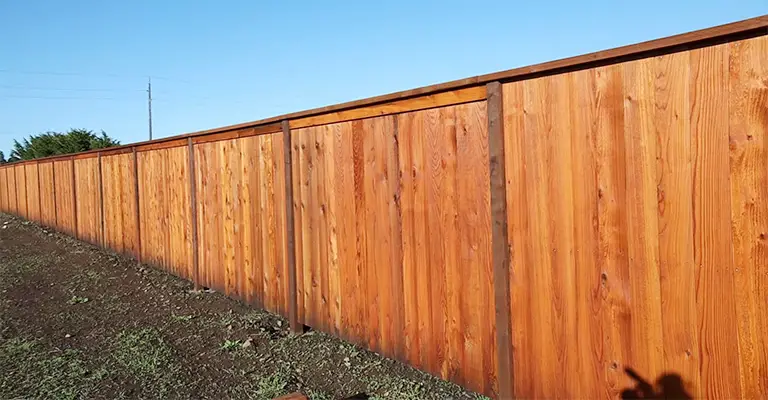
The inside of their fence may be the only part they want to stain. Since that’s the side they’re most likely to look at, that’s what they’re most likely to see.
It will be necessary for them to look at the fence whenever they are in the yard. Despite some enjoying the natural look of an aging wooden fence, not everyone enjoys it.
Benefits Of Staining And Sealing Fences
Sealing and staining wooden fences is essential to keep them looking good, particularly if they have been made out of softwood such as pine.
Despite pressure treatment for infestation and rot protection, pine can warp if it gets very wet, especially if it dries out quickly.
There is a high risk of this happening. A sealant prevents water from seeping into the wood and also protects it from UV rays, thereby avoiding discoloration and fiber breakdown.
Pressure-treated wood, however, may be prone to moisture, and moisture inhibits the penetration of stains and sealants for a while.
It is not necessary to pressure-treat hardwoods such as cedar, as they contain natural oils that prevent infestation and rot.
The result is that hardwood can generally be sealed right away. Although sealing won’t change the wood’s structural integrity, it will turn gray and look aged.
Occasionally, homeowners ask whether they should seal both sides of a fence. Generally speaking, this approach is the most effective, but it is not a rigid rule.
Realistically, a fence that faces a neighbor without staining or sealing will discolor, but not yours, as neither will affect the structure’s structural integrity.
When To Stain And Seal Fences?
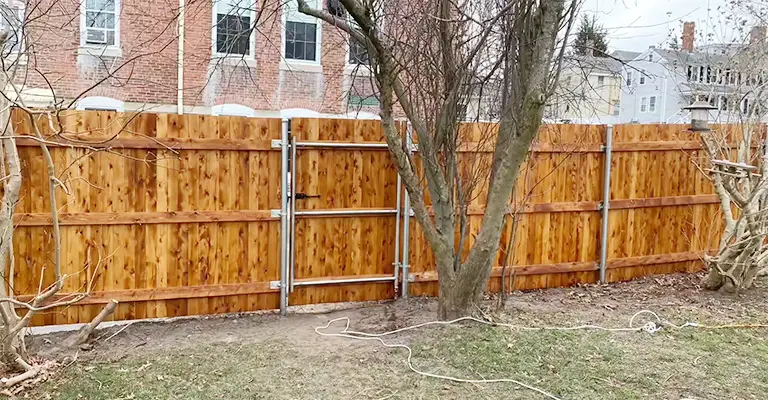
Before staining and sealing your fence, wait four to eight weeks after installing it. As the wood dries, the moisture content will decrease.
Depending on the wood, the waiting time may be longer if it has been pressure-treated. As a rule of thumb, it will be easier to make the process if it is drier.
Since it’s so hot in the summer, staining and sealing your fence is an excellent idea. It is not recommended to use these products in direct sunlight.
What If I Can’t Access the Back of My Fence?
You may be unable to stain the back of your fence if a neighbor is bothersome or if another fence runs along it. Then it might be a good idea to upgrade to a fence that doesn’t need staining.
Even though the initial cost might be higher than staining, at least the fence won’t need to be maintained in the future.
How Often Do Fences Need To Be Stained?
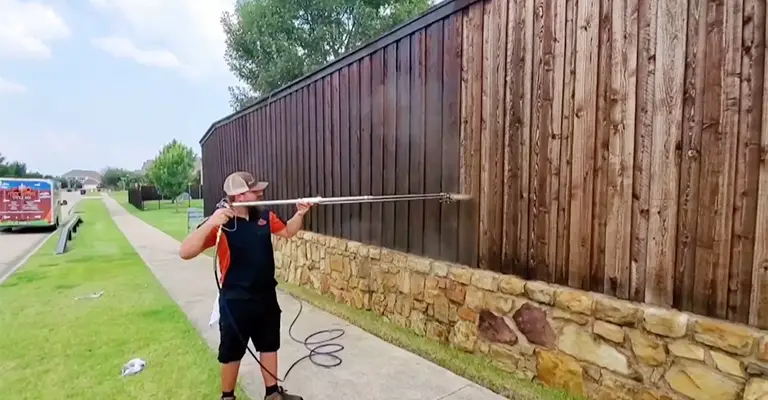
Staining wood fences every 3-5 years is recommended, although some fences will require staining more frequently.
In fact, the stain on one side of your fence can fade faster than it does on the other side, depending on how much sun your fence gets.
Our fence projects are stain-treated with top-quality products to help reduce frequency.
Is My Neighbor Responsible For Staining Their Side Of The Fence?
Putting this question into words is not easy. As a result of splitting the cost of your connecting fence with your neighbor, you may also want to split the cost of staining.
Despite this, you shouldn’t take on this project to recoup your investment. All things on your property are your responsibility, including the side of the fence you may not see.
Your fencing investment will save you money in the long run because of its durability and longevity. Staining your fence should be discussed with your neighbor before you do it.
Regardless of whether they cannot pay for some of the staining, they need to be aware that fence strainers need access to their property.
Your fence installation will go much more smoothly if you coordinate with your neighbors.
Can We Legally Paint Our Side Of A Neighbor’s Fence?
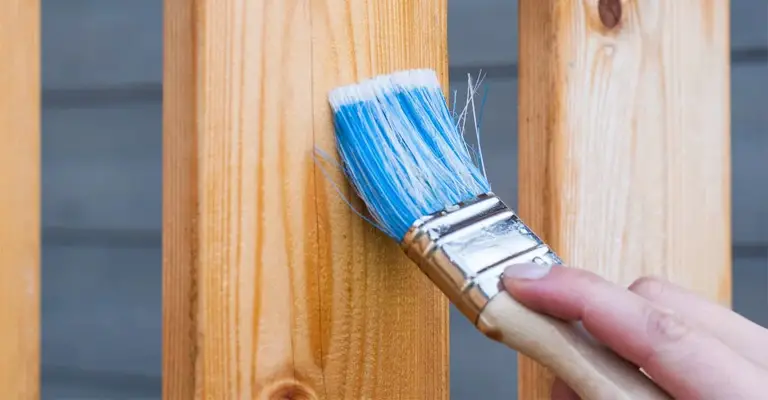
Probably not.
Depending on state and local laws, if your neighbors’ fence was installed properly, it is likely entirely on their property.
By painting on their property, you would likely trespass and vandalize their property.
Talk to your neighbor about painting the side facing your property and let him/her know what you intend to do.
Your neighbor may just give you a thumbs up, but they may have plans on what to do with it. Since it is their fence, it is their responsibility.
Choose a Fence That Doesn’t Require Staining
In the short run, wood fences are cheaper than other materials. However, the need to stain them frequently adds up over time. Choosing a manufactured fencing material such as vinyl or composite can be easier and less time-consuming.
Wooden fences look beautiful, but they don’t need to be stained every few years, so you don’t need to worry about that.
Final Words
To maintain wood fences, fence staining is essential. It not only enhances the fence’s appearance but also protects it from damage.
You may not know how to build a fence connecting to another person’s yard. Therefore, if your wooden fence requires more and more maintenance every year, installing a new one is a good idea.







